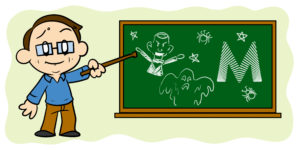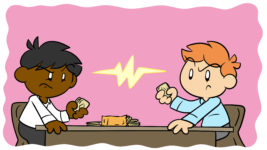Not long ago, we discussed the subgenre of bizarro fiction, identifying what makes it unique and separating it from similar movements such as transgressive fiction and new weird fiction. This time around, we’re zeroing in on that final category of writing and asking, ‘What is the new weird?’
It’s a question we’re going to answer in full, but it’s also worth taking a moment to identify why that answer matters. First, because great writing is about making choices, and the more information you have at your disposal, the more choices you’ll be able to make. Knowing what other authors are writing is to your benefit, even if you’re writing in a different genre, because it gives you an idea of the modern marketplace and insight into your own literary options.
Second, because you may already be writing new weird fiction. It’s pretty common for artists to have the same goals without knowing about each other – a lot of artistic movements are only defined in retrospect – and lots of writers work in a subgenre for years without knowing there are resources out there for them or even that there’s a name for what they’re attempting. That name is valuable, because it’s one of the best tools for finding new readers.
So, that’s why you should care about new weird fiction. Now, what exactly is new weird fiction?
What is new weird fiction?
As with most subgenres, new weird fiction is most easily explained via its most prominent practitioners. New weird figureheads include China Miéville, Jeff and Ann VanderMeer, Ian R. MacLeod, Justina Robson, Steph Swainston, and M. John Harrison, among others.
That’s where to look if you want your understanding of new weird to emerge from practical experience, but let’s try and find a definition for new weird fiction that’s more consistent than just the writers who make it up.
It shouldn’t be surprising that ‘new weird’ fiction has a relationship to ‘weird’ fiction. In fact, it has a relationship with many other subgenres, including ‘bizarro’ fiction and ‘slipstream’ writing.
What these subgenres have in common is an ever-evolving attempt to escape the established boundaries of genre fiction. ‘Genre fiction’ generally refers to science-fiction, fantasy, and horror writing, though the term has lost a lot of its meaning as these genres have grown both in terms of their internal definitions (what counts as ‘fantasy,’ for example) and in terms of their relevance to pop culture (our biggest media properties now dabble liberally in sci-fi and fantasy, as opposed to those genres being niche interests.)
The boundaries being pushed are always changing, and thus so are the subgenres doing the pushing. Weird fiction was once the new movement redefining what genre fiction could do, but once it was successful, new weird came along to take things further. This constant evolution makes each subgenre hard to completely codify, and there’s no literary council to make pronouncements from on high – there are books that some people call new weird which others would say are just modern sci-fi, fantasy, or horror.
This makes it hard to pin down new weird, but the good news is that’s exactly as it should be. New weird fiction seeks to challenge and escape old clichés, sometimes by warping them beyond recognition, and sometimes just by transgressing the boundaries they define. In ‘A Beginner’s Guide to the New Weird Genre,’ Mya Nunnally explains:
As an example: in the Bas-Lag series, a giant spider with hands of a human baby spouts post-modernist poetry and travels between dimensions. There’s a race of cactus people. There’s a sword that exists and kills in multiple places at once.
These certainly aren’t generic staples of fantasy. In fact, it feels odd describing these novels as such when there truly isn’t much else in the larger genre like it. Does this really belong in the same group as Game of Thrones or The Lion, The Witch, and the Wardrobe?
So, is new weird fiction just genre fiction that happens to push boundaries? Not quite. New weird is part of a movement that is specifically concerned with this kind of boundary pushing, and that attitude permeates it down to the bone. One book that arises as a constant ‘is it or isn’t it?’ example of the new weird is Mark Z. Danielewski’s House of Leaves. Danielewski’s book is a post-modern horror story in which nested narratives influence how the reader perceives each separate set of events. Did the central horror story ever actually take place? The characters would like to know as much as the reader… if they exist, that is.
There’s a convincing argument that House of Leaves is new weird. After all, it blends horror with fantasy and sci-fi elements (is there a monster within the haunted house, or are the characters misunderstanding a seemingly impossible scientific phenomenon?) There’s also a convincing argument that Danielewski’s book is just modern horror – its sci-fi and fantasy elements are minimal, especially in a culture conversant in genre fiction, and it doesn’t seem concerned with deliberately tearing down horror clichés, employing several to great effect.
If House of Leaves is new weird fiction, it’s not a great example, because it doesn’t really approach genre expectations with hostility (or, if it does, it does so with extreme subtlety.) That hostility is better described by Robin Anne Reid, who Nunnally quotes as saying that new weird intends to ‘subvert clichés of the fantastic in order to put them to discomfiting, rather than consoling, ends.’
This is a useful observation, even as it’s not the whole truth. It’s true that a lot of the conventions of the fantasy genre (though not every example of fantasy literature) tend to be couched in reader comfort, whether that’s in depicting simplified versions of feudal societies or staying a little too close to the standards set down by J.R.R. Tolkien’s body of work, and new weird is certainly predicated on eschewing this type of comfort.
Much modern fantasy may move past the comforting ideas described above, but new weird is different because it specifically sets out to take them down. New weird doesn’t just want to be free, it wants to wreck things on its way out. Where Reid’s description comes up short is that new weird isn’t just out to take down pastoral fantasy – it wants to tear up the rule book for science-fiction, horror, crime, and any other genre that’s starting to feel restrictive.
So, finally, we have an idea of what the new weird is about, right? Almost! One final delineation is important – while new weird is an anarchic, experimental, transgressive genre, it’s also concerned with literary quality. Of course, every writer wants to write something good, but new weird writers want to justify tearing up the rulebook by showing that we’re genuinely better off without it.
This attitude can best be understood in contrast to bizarro fiction. Now, bizarro fiction writers still want to tell an entertaining story, and they still want to write well, but they treat anarchism and experimentalism as goals in their own right. If a bizarro writer can show you something entertaining that behaves in a way you’ve never seen before, they’ve done their job. In contrast, new weird writers are a little more concerned with literary craft, and that means they tend to value structure and internal consistency.
People buy New Weird because they want cutting edge speculative fiction with a literary slant… Another thing that separates Bizarro and New Weird is that Bizarro leans toward the humorous, low-brow side. New Weird leans toward the literary, high-brow side. There is Bizarro that is smart and there is New Weird that is fun, but for the most part they are separated because bizarro is mostly for entertainment and New Weird shoots to be high art.
– Rose O’keefe in Randy Henderson’s ‘Bizarro Fiction 101: Not Just Weird for Weird’s Sake’
Finally, we have our understanding of new weird fiction: writing that seeks to explicitly transgress the existing boundaries of genre fiction in pursuit of new works of literary merit which couldn’t have emerged from the prior status quo. Simple!
Writing good new weird fiction
Now we have our definition of new weird fiction, let’s take a look at how to write it. As a subgenre built on transgressing rules, it would be a mistake to try and pin down exactly how to write good new weird fiction, but we can look at three things you’ll need to get started.
1. Genre literacy
To say that new weird writers don’t care about the traditions and expectations of genre fiction would be inaccurate – they care a great deal, as anyone does about something they want to destroy.
If you want to write original genre concepts, go ahead; be the bleeding edge of sci-fi, fantasy, or horror. If, on the other hand, you want to write new weird, you need to be able to identify the barriers you’re trying to tear down, because that’s the only way to attack them effectively.
If anything, new weird writers need a better grasp of genre fiction than people writing in those genres. Courting the king’s favor is one thing, but if you want to take him out, you need to know his habits.
2. Optimism
While new weird fiction holds old paradigms in a certain contempt, that’s only because – as a movement – it holds the genres to which they apply in such high esteem. New weird writing doesn’t treat genre writing as outdated, but rather as an amazing artistic force that’s being held back by outdated rules. New weird authors really believe in genre writing.
If you don’t have that love in you (if, for example, it’s the genres themselves you hold in contempt) then new weird fiction will be a poor fit. For all their dark ideas and disgusting creations, new weird writers are optimistic about art.
If the New Weird writers represent a turning point it is because they are the first generation of writers to grow up completely immersed in the culture of sci-fi. For such writers the language of speculative fiction is the first and preferred means of expression, because it is the only way to describe a real world permeated on every level with unreality, fantasy and fiction. Whatever the Next Weird may bring, it seems certain that the real experimental energy of literature will remain in genre fiction.
– Damien G. Walter, ‘The new world of New Weird’
3. More than one idea
One of the best tools in a new weird writer’s toolkit is variety. In our article on bizarro fiction, I talked about how bizarro authors stack one weird idea on another on another, with the aim that the reader is always experiencing something new.
Because of their literary aspirations, new weird writers tend to write worlds which are more internally consistent, but those worlds are still varied in their… well, weirdness. It’s not enough to simply think up one strange thing about your fictional world – instead, a new weird world should be made up of a variety of different inventions. Characters should be unusual in more ways that one, as should the setting, as should the plot.
To get an idea of how this looks in action, check out Nunnally’s synopsis of Jeff VanderMeer’s Borne:
In Borne, the main villain is a gigantic, flying, mutated bear. No, that’s not a metaphor. Mord is truly a mutated bear that can fly and this book doesn’t care if you think that’s absurd. Borne is the perfect solution for your science fiction or fantasy rut. In a world ravaged by biotech gone awry, there’s nothing normal and nothing safe here. Borne himself is a sentient plant creature developing into its own being and bringing danger wherever he goes.
Having your protagonist have to deal with a gigantic, flying, mutated bear is one thing, but also having that protagonist be a sentient plant is where things get new weird. If you’ve got one genuinely weird idea, write some excellent speculative fiction. If you’ve got seven, write new weird.
The new weird
Any movement built around transgressing boundaries is constantly changing, and while ‘new weird’ is an identifiable subgenre, it’s also part of a constant process of experimentation. Some of those experiments will end badly, some will end well, but they’re all intended to push the boundaries of modern genre writing and discover what else it can be.
If you want to be part of that process, get writing, and try to stay truer to the idea behind new weird fiction than to any one person’s definition of it. Let me know what you discover on your travels, and check out Writing Transgressive Fiction? Here’s What You Need To Know and What Makes Fiction Bizarro, And What Makes Bizarro Awesome? for more on the experimental edge of genre writing.





